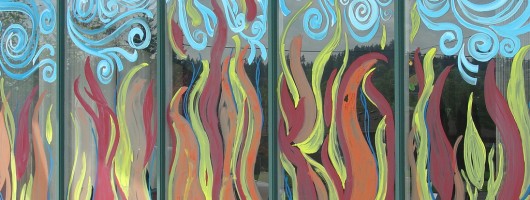Waiting for the Spirit
Posted by Isaac Butterworth | Filed under Liturgical Year, Missional Church

A few years ago, as I was hiking the Elliott Barker Trail just outside of Angel Fire, New Mexico, I was praying, asking God to give me some clarity with regard to a vision for our church and its mission. What came to mind as I walked and prayed that day was a process in which God’s people are “called by love, nurtured in love, and sent to love.” I began to think about:
- worship as the setting in which God (in love) calls us,
- study and fellowship as the settings in which God (in love) nurtures us, and
- ministry, mission, and service to others as the settings to which God (in love) sends us.
I like this way of looking at the church’s vision because it affirms the initiative of God. For some time now, I have had the conviction that the mission is God’s (the missio dei) and that we, as the church, are invited to participate in it.
Last year, I came across Joseph A. Tetlow’s book, Making Choices in Christ, and discovered in it a statement that reads: Ignatian spirituality, even in the beginning,
was applied to a ‘communitas ad dispersionem,’ as the Jesuit constitutions put it — a community set up explicitly to be dispersed into mission. This spirituality was meant to empower a dynamic service of God out in the marketplace” (p. 2).
After reading this, I thought of a possible vision statement for the church:
A community of faith
empowered by a deepening spirituality
for dynamic service of God
in the marketplace of life.
It has in it all the aspects of “Called by Love — Nurtured in Love — Sent to Love,” in a slightly different order.
It begins with nurture: “a community of faith.” It then picks up call: “empowered by a deepening spirituality.”
And it ends in the mission (that for which we are sent): “dynamic service of God in the marketplace of life.”
This coming Sunday, May 23, is Pentecost. It is a day on which the community of faith remembers the coming of the Holy Spirit upon the church with wind and fire and sound. It is also a day on which we celebrate the Spirit’s presence in our common life and seek the renewal and empowerment that the Spirit offers for the missio dei.
“Empowered by a deepening spirituality,” as Tetlow says, the community of faith (the church) will be found in the marketplace of life engaging in dynamic service of God.
Veni, Sancte Spiritus, known as the Golden Sequence, is used at the Mass for Pentecost. It is an ancient hymn that expresses the church’s desire for the Spirit to come. The first stanza goes like this:
Come, Holy Spirit: Fill the hearts of your faithful and kindle in them the fire of your love.
Send forth your Spirit, and they shall be created.
And You shall renew the face of the earth.
That is the grand end toward which God is moving. That is the end point of the missio dei — the renewal of the face of the earth. “Then I saw a new heaven and a new earth,” John writes (Revelation 21:1, NRSV). The new creation restored: it is this for which we long and toward which we labor as God’s “inspirited” people.
Come, Holy Spirit: Fill the hearts of your faithful and kindle in them the fire of your love!
Have a blessed Pentecost.
Photo Credit: Window Painting for Pentecost Sunday | First Christian Church, Puyallup, Washington | Robin Crabb







May 21, 2010 at 4:41 pm
Wow, Ike!!! I especially love the possible vision statement!
May 23, 2010 at 10:20 pm
Thank you, Carol.